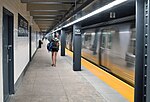Episcopal Diocese of New York

The Episcopal Diocese of New York is a diocese of the Episcopal Church in the United States of America, encompassing the boroughs of Manhattan, the Bronx, and Staten Island in New York City, and the New York state counties of Westchester, Rockland, Dutchess, Orange, Putnam, Sullivan, and Ulster. Established in 1785 after the success of the American Revolution resulted in the dis-establishment of the Anglican Church, it is one of the nine original dioceses of the Episcopal Church. It is one of ten dioceses, plus the Convocation of Episcopal Churches in Europe, that make up Province 2. The diocesan offices are located in Manhattan near the Cathedral of St. John the Divine on Amsterdam Avenue. The Diocesan bishop is Andrew M. L. Dietsche, 16th Bishop of New York, assisted by Allen K. Shin, Suffragan Bishop, and Mary Glasspool, Assistant Bishop.
Excerpt from the Wikipedia article Episcopal Diocese of New York (License: CC BY-SA 3.0, Authors, Images).Episcopal Diocese of New York
Manhattan Avenue, New York Manhattan
Geographical coordinates (GPS) Address Nearby Places Show on map
Geographical coordinates (GPS)
| Latitude | Longitude |
|---|---|
| N 40.8 ° | E -73.96 ° |
Address
Manhattan Avenue 200
10025 New York, Manhattan
New York, United States
Open on Google Maps











